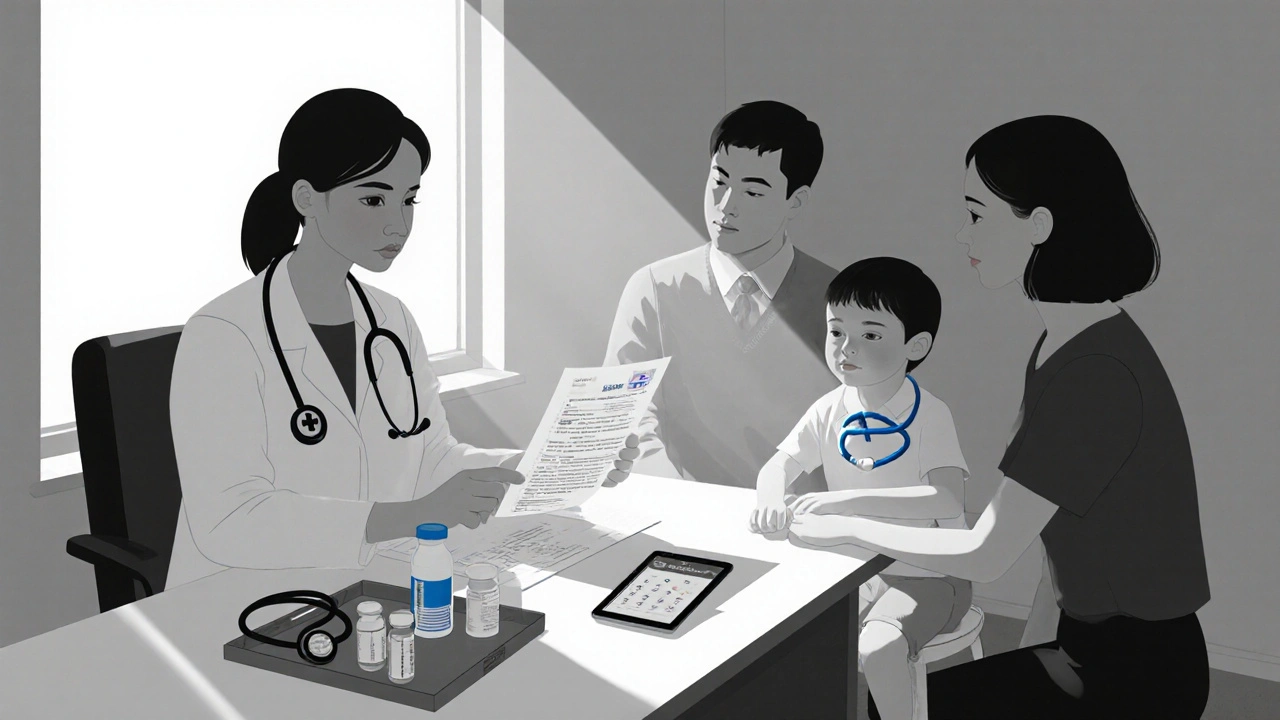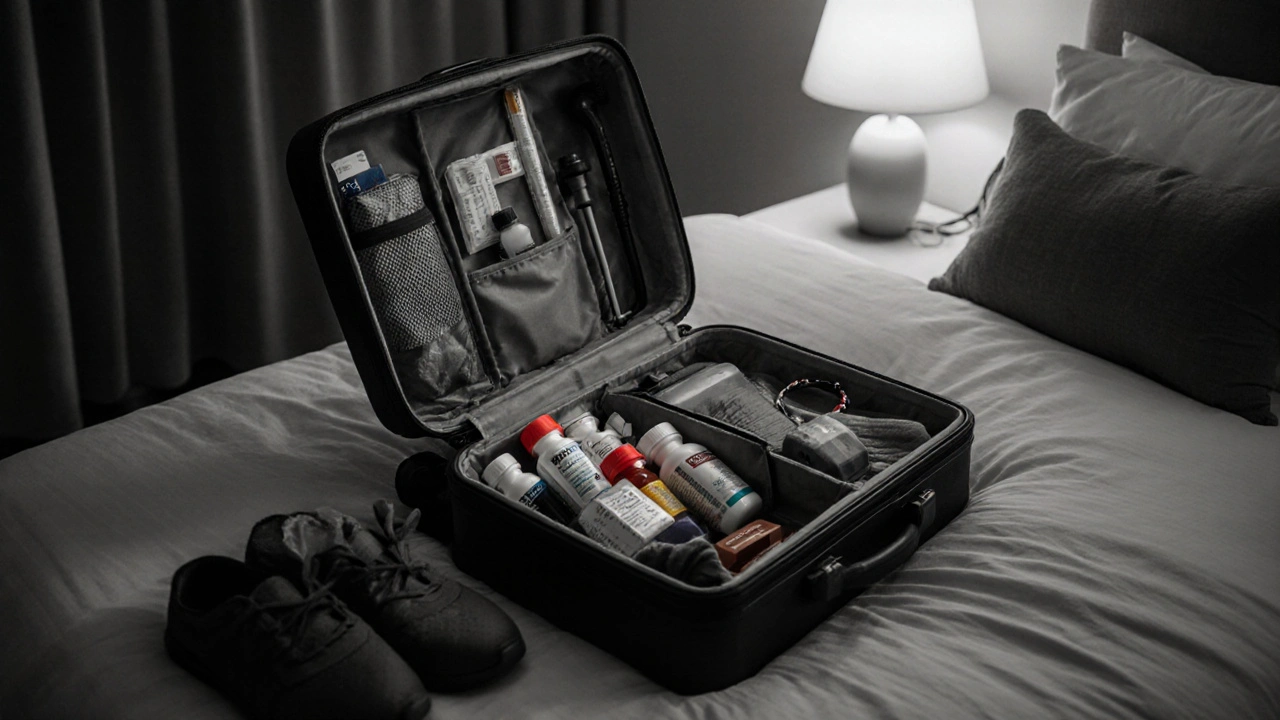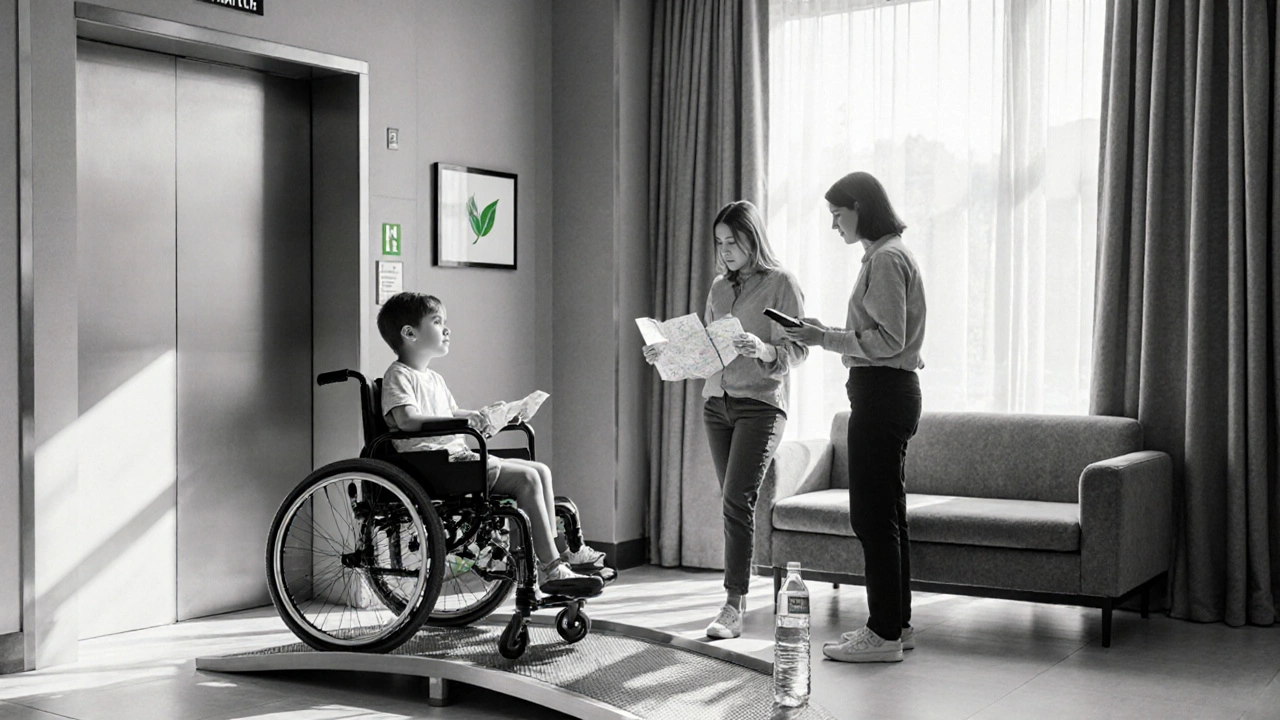Essential Travel Tips for Families Managing Juvenile Arthritis

Medication Calculator for Juvenile Arthritis
Calculate Your Medication Supply
Determine how many days of medication you need for your trip, including buffer days and time zone considerations.
Medication Quantity Needed
Juvenile Arthritis is a chronic inflammatory condition that affects children’s joints, causing pain, swelling, and reduced mobility. When a family plans a getaway, the extra layers of medication schedules, mobility needs, and flare‑ups can feel overwhelming. The good news? With a bit of foresight and the right tools, you can turn a daunting trip into a smooth, enjoyable experience for everyone.
Key Takeaways
- Start with a pre‑trip medical check‑up and update the medication plan.
- Pick destinations with moderate climate and easy access to medical facilities.
- Pack a travel‑ready arthritis kit that covers meds, mobility aids, and pain‑relief supplies.
- Build daily itineraries that balance activity and rest to prevent flares.
- Create an emergency plan that includes local doctors, pharmacies, and insurance details.
1. Medical Prep: Talk to Your Rheumatologist Early
Before you book tickets, schedule a visit with your child’s rheumatologist. Ask about adjusting dosages for time‑zone changes, confirming that the child’s Medication supply will last the entire trip, and whether any new prescriptions (e.g., short‑term steroids) might be needed. Request a concise medical summary-name, diagnosis, medication list, dosage, and emergency contact-that you can hand to any local doctor.
2. Destination & Climate: Choose Arthritis‑Friendly Locations
Extreme temperatures can aggravate joint pain. Aim for moderate climates-think late spring in the UK, early autumn in the Mediterranean, or mild mountain towns. If you’re heading to a warmer destination, plan indoor breaks during the hottest part of the day. Check that the area has reputable hospitals or pediatric rheumatology clinics; a quick online search of "Family friendly medical centers" often yields reliable results.
3. Packing Smart: The Arthritis Travel Kit
Every family should have a dedicated “arthritis kit” that fits in a carry‑on. Include:
- All prescribed Medication, plus a few days extra.
- Over‑the‑counter pain relievers (ibuprofen, acetaminophen) for unexpected flare‑ups.
- A portable cool pack or heating pad (battery‑operated models are travel‑friendly).
- Any required Mobility Aids (brace, lightweight wheelchair, walking stick).
- Copies of medical records and a list of local doctors at the destination.
- Comfortable, supportive shoes with good arch support.
Label everything clearly and keep the kit in a separate compartment for quick access.

4. Managing Pain on the Go
Flare‑ups can happen at any time. Here are practical steps:
- Stick to the medication timetable-use phone alarms set to the destination’s local time.
- Apply a warm compress before long walks or a cool pack after intense activity.
- Encourage gentle stretching every few hours; a short video on kid‑friendly joint exercises works well in hotel rooms.
- Stay hydrated-dehydration can increase joint stiffness.
5. Mobility Matters: Selecting Accessible Accommodation
Where you stay can make or break the trip. Below is a quick comparison of three common lodging types and how they stack up for a child with juvenile arthritis.
| Feature | Hotel | Vacation Rental | Resort |
|---|---|---|---|
| Elevator access | Usually available | Varies - check listings | Standard in most resorts |
| Room layout (space for mobility aid) | Standard size, may need request | Often larger, can request ground‑floor | Spacious suites, often handicap‑ready |
| On‑site medical help | First‑aid staff, limited | None, rely on local services | Clinic or nurse station in many resorts |
| Nearby rest areas | Lobby chairs, poolside | Depends on property | Plentiful shaded benches |
| Price flexibility | Mid‑range | Can be higher or lower | Often premium |
When booking, use keywords like "wheelchair accessible" or "ground floor" and call ahead to confirm elevator availability and room dimensions.
6. Planning Activities & Rest Breaks
Kids love adventure, but pacing is key. Build an itinerary that alternates high‑energy outings with low‑key periods:
- Morning: Light sightseeing (museum, park) when joints are freshest.
- Midday: Lunch break with a shaded spot; use this time for gentle stretches.
- Afternoon: Optional activity (boat ride, short hike) followed by a rest period.
- Evening: Calm family dinner and a short, soothing warm bath to relax muscles.
Having a flexible schedule reduces stress for both parents and the child.

7. Emergency Planning: The Emergency Kit and Insurance
Never travel without an emergency plan. Include:
- Contact numbers for the child’s rheumatologist, the nearest hospital, and the travel insurance hotline.
- Copies of insurance cards and a brief medical summary.
- A list of local pharmacies that carry the prescribed meds.
- Portable medical alert bracelet stating "Juvenile Arthritis - requires medication".
Check that your travel insurance covers pre‑existing conditions and that you understand the claim process before you leave.
8. Final Checklist Before You Go
- Confirm travel dates with rheumatologist; adjust meds if crossing time zones.
- Book accommodation that meets mobility and medical‑aid needs.
- Pack the arthritis travel kit in a carry‑on.
- Download offline maps of nearby hospitals and pharmacies.
- Set phone alarms for medication times in the destination’s time zone.
- Brief your child on the plan-show them the kit, explain rest breaks, and answer any questions.
With these steps, you’ll feel prepared, and your child will have a vacation that’s fun, safe, and pain‑managed.
Frequently Asked Questions
Can a child with juvenile arthritis fly safely?
Yes. Flying is generally safe, but plan to stay hydrated, move the legs regularly, and bring any needed inhalers or pain meds. Discuss any concerns with the rheumatologist before booking.
What if the child has a flare‑up while on vacation?
Use the travel kit’s cooling pack or heating pad, take the prescribed rescue medication, and rest in a comfortable spot. If symptoms worsen, contact the nearest medical facility listed in your emergency plan.
Are there specific activities that should be avoided?
High‑impact sports (e.g., rugby, skateboarding) can trigger pain. Opt for low‑impact activities like swimming, gentle cycling, or guided nature walks. Always have a rest break ready.
How do I handle medication storage on a plane?
Keep meds in the original prescription bottles, and place them in a carry‑on. Declare them at security if asked and have the doctor’s note handy for liquid meds exceeding 100ml.
Is travel insurance worth it for a child with juvenile arthritis?
Absolutely-look for a policy that covers pre‑existing conditions, emergency medical evacuation, and medication loss. Review the fine print to avoid surprises.
12 Comments
karl lewis
While the guidance presented is commendably thorough, one might argue that the emphasis on climate selection borders on the pedantic. After all, families often possess innate adaptability, rendering exhaustive climate analyses superfluous. Nonetheless, the inclusion of medication schedule adjustments is a prudent reminder. :)
Amy Martinez
Reading this felt like a warm lantern in a stormy night-bright, reassuring, and full of practical sparkle. I can picture a family unpacking that thoughtfully stocked arthritis kit, feeling a collective sigh of relief. The suggestions to sprinkle gentle stretches between adventures paint a vivid picture of balance and care. Kudos for weaving medical prudence with the joy of travel.
Josh Grabenstein
Sure, just pack a cooler pack and hope the airline doesn’t confiscate your meds.
Marilyn Decalo
Oh, the drama of planning a vacation when every joint could decide to rebel! This guide reads like a survival manual for a family quest, complete with checkpoints and hidden traps. The stakes feel high, but the reassurance that a simple warm compress can save the day adds a heroic twist.
Mary Louise Leonardo
Alright folks, grab that arthritis travel kit like it’s a treasure chest, because we’re heading to the sunshine! Pack extra meds, a comfy pair of shoes, and don’t forget the cool pack-your secret weapon against surprise flare‑ups. Remember, a quick stretch break is like a mini‑vacation for the joints. Let’s make this trip as painless as possible, okay?
Alex Bennett
Indeed, the checklist resembles a military operation, and who doesn’t love a good parade of bullet points? Yet, the advice to schedule alarms for medication is a lifeline-especially when toddlers decide the nightstand is a launchpad. Consider this your friendly reminder that a little foresight turns a potential nightmare into a manageable adventure.
Mica Massenburg
Interesting take, though one could wonder if the “military operation” analogy masks deeper anxieties about control.
Sarah Brown
Let’s cut the theatrics and focus on the facts: a well‑packed kit and realistic expectations are what keep families afloat, not dramatic flair.
Matt Quirie
It is evident, upon careful examination of the enumerated steps, that adherence to pre‑travel medical consultation, appropriate climate selection, and systematic packing of a dedicated arthritis kit, collectively constitute a robust framework for mitigating potential complications; moreover, this framework is reinforced by the inclusion of emergency planning and insurance considerations, thereby ensuring a comprehensive safety net for the traveling family.
Pat Davis
From a broader perspective, the recommendations echo universal principles of accessible tourism, emphasizing inclusivity, medical preparedness, and environmental adaptability. Such guidance aligns with international standards for travel accommodation of individuals with chronic conditions, thereby fostering a more equitable travel experience.
Mary Wrobel
Love the vibe here-practical tips wrapped in a friendly tone make the whole thing feel like a chat over coffee. Keep the advice coming, it’s the perfect blend of realism and optimism.
Just Sarah
Upon meticulous review of the presented travel protocol, one observes a commendable synthesis of clinical prudence and logistical acumen, which, in concert, serve to attenuate the inherent risks associated with juvenile arthritis during itinerant excursions. The initial injunction to secure a pre‑travel rheumatological assessment is, by necessity, the cornerstone upon which subsequent measures are predicated, for it furnishes both a comprehensive medication reconciliation and a tailored flare‑prevention strategy. Equally salient is the counsel to elect destinations characterized by temperate climates, a recommendation that judiciously mitigates thermally induced exacerbations of synovial inflammation. The delineation of a portable arthritis kit, replete with prescription medications, analgesic adjuncts, thermally modulatory devices, and redundant documentation, constitutes a microcosm of redundancy engineering, thereby safeguarding against unforeseen supply chain disruptions. Moreover, the emphasis placed upon temporal alignment of dosing schedules with the target time zone, facilitated through calibrated mobile alerts, addresses the pharmacokinetic volatility that may otherwise culminate in sub‑therapeutic exposure. The advocated itinerary architecture, which intersperses periods of moderate activity with restorative interludes, embodies the principle of load management, a tenet well‑established within physiotherapeutic discourse. In parallel, the recommendation to prioritize accessible lodging, complete with elevator access and spacious room configurations, directly confronts the spatial constraints imposed by mobility aids, thereby preserving functional autonomy. The integration of an emergency contingency plan, inclusive of local medical contacts, insurance particulars, and portable medical identification, further augments the resiliency of the travel schema. It is noteworthy that the guide also underscores the importance of hydration, a physiologic variable that exerts a nontrivial influence on joint lubrication and overall comfort. The cumulative effect of these stratagems is a robust, multi‑layered defense against the vicissitudes of disease activity encountered away from the home environment. While the document adeptly addresses the logistical dimensions of travel, it also subtly encourages psychosocial empowerment by involving the child in the preparatory process, thereby fostering a sense of agency. In summation, the comprehensive nature of the recommendations, their evidentiary grounding, and their pragmatic orientation coalesce to form an exemplary template for families navigating the complexities of juvenile arthritis in the context of travel.






Write a comment